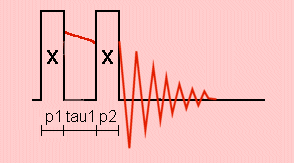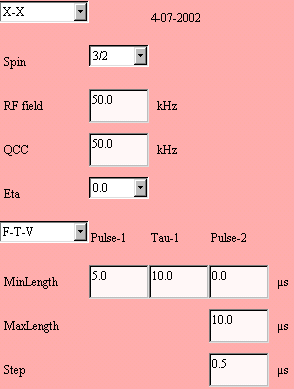AIM: Determination of the quadrupole coupling constant from a featureless NMR lineshape
Launch the two-pulse applet with Java Web Start.

Two-pulse nutation experiments with a short interpulse delay tau1 are more versatile than one-pulse nutation experiment: We can perform two experiments with different acquisition parameters on the same sample. The fitting of these two nutation data should provide us with the same quadrupolar coupling constant. A short tau1 avoids the formation of echoes. Three two-pulse sequences are presented:
|
X-X: {+X}-tau1-{+X}-acq(+y) Even-X: {+X}-tau1-{+X}-acq(+y) {-X}-tau1-{+X}-acq(+y) Odd-X: {+X}-tau1-{+X}-acq(+y) {-X}-tau1-{+X}-acq(-y) |

The left part of the simulation panel indicates the physical parameters. It is preset for a typical experiment on a spin I = 3/2 in a powder. You can introduce your own values.
First, we select one of the two-pulse sequences available with the upper choice box.
Then, we select one of the two types of line intensity calculation
with the lower choice box:
(1) V-T-F: p1 is variable and p2 is constant,
tau1 being a parameter;
(2) F-T-V: p1 is constant and p2 is variable,
tau1 being a parameter.
A constant length should be provided in the MinLength field.
MinLength: the first variable pulse-length in µs
MaxLength: the last variable pulse-length in µs
Step: the increment of the variable pulse-length in µs
The following applet is initialized for the central-line intensity of a spin I = 3/2 in a powder excited by the X-X two-pulse sequence, where p1 = 5 µs, tau1 = 10 µs, and p2 increases from 0 to 10 µs by 0.5 µs step. The experimental line intensities are identical to the simulated ones.
Help for selecting all the simulated data of the line intensity text area in a JDK1.1.8 applet.
